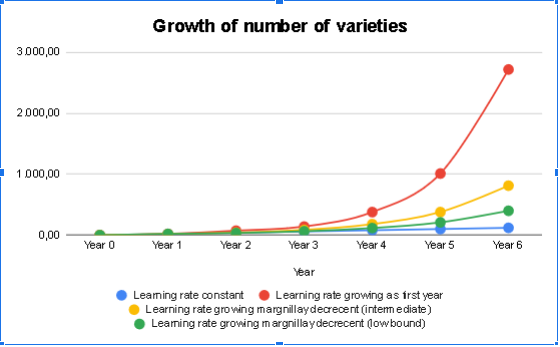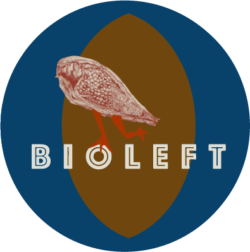Bioleft went through a process of intense growth in its early years, becoming a laboratory of research, co-design and implementation of tools for conservation, dissemination and open and collaborative seed breeding. Within the framework of an agrifood system with severe sustainability problems, our purpose is to support transformative forms of agriculture, such as agroecology, which require a plant diversity today threatened by concentrated agricultural practices. Ensuring the circulation of genetic material is fundamental to guaranteeing biodiversity and supporting innovative solutions to the challenges of food security and sovereignty.
We were born as a research project, but we quickly took action. After a first incubation period, today we are going through a second stage in which we are testing and improving our first tools and expanding networks and objectives. It is a propitious moment to look back and to extract lessons from what we have lived: how we got here, what we learned and how we can imagine the future of Bioleft.
Learning to grow
Bioleft was born small: an idea and a lot of enthusiasm on the part of a group of researchers concerned about the magnitude, speed and irreversibility of changes in seed breeding systems. Fewer and fewer companies, fewer and fewer seed varieties, less and less access, fewer and fewer farmers, and therefore, possible agricultures. The original idea was to design and experiment with an open source license for seed transfer and thus ensure its free circulation for future breeding. The companies use the tools of the system to close the seeds, so that they cannot be accessed. We set out to use these same tools to ensure that seeds remain open: hack the system. But in working with participants from diverse social and productive spheres we realized that the challenges and possibilities were manifold; a democratic and sustainable alternative was possible, but to start co-constructing it we had to expand our objectives and our networks.
So, with dynamic goals that were redefined at every step and conversation, we moved forward: from a license-centered approach to devising technology-driven social innovation tools. We expanded our team, and began to work on the co-design of multiple tools for an alternative plant breeding system: we focused on the development of a digital platform, which would transfer seeds with traceability, share information, link existing capacities that were dispersed until now and thus create new knowledge. Researchers were not enough to design tools, test them, implement them, make them work. We began to work collaboratively; we added to our team and network of contacts different types of agricultural producers, seed breeders from both the public and private sectors, small and family agriculture organizations, researchers and public servants.
This diversity of perspectives brought dynamism, flexibility and resilience to change course when necessary. In practice it functioned as an intensive laboratory of social innovation. The multiplication of actors and contacts, both local and national and international, generated a network effect that enabled significant learning in a short period of time, and facilitated dissemination, which in turn brought more and better contacts. This led us to our third focus, after licensing and the platform: international expansion. Since June 2019, we have been working on the implementation of Bioleft in Mexico, together with the Sustainability Sciences Laboratory of the National Autonomous University of Mexico (UNAM), and we have links with organizations related to agricultural sustainability in Colombia and Chile. We are also part of the Open Source Seeds Initiative (OSSI), along with organizations from four continents.
Two periods, one development
In order to summarize Bioleft’s growth and analyze the process, we decided to compare two periods: that of the official launch as Bioleft, 2018-2019, during the final stage of the research program that incubated us, and our second phase, 2019-2020, in which we worked on testing and breeding with the support of other organizations. The results of the comparison are impressive: during the first period, the incorporation of actors, partners and seeds was slow; but in the second, all the variables multiplied, with rates of up to 2000%. Let’s look at it in detail.
We chose to measure our evolution with a series of variables arranged in two groups: one relating to our network of institutions and associated people, and the other relating to seed and food production. In the first group, we measure the number of actors and institutions we work with in each period: breeders, farmers-breeders, agricultural producers; companies, farmers’ organizations, experimental stations and seed banks. In the second group of variables, we count the number of crops and varieties registered in Bioleft, the number of hectares sown with these seeds, the kilos of seeds distributed and two types of sowing products: kilos of food and seeds.
From the comparison of these variables between the two periods, we calculated a growth rate that resulted of 154% in the variables related to the network of institutions and actors, and of 267% in relation to productive variables.
Network of institutions and people
Our first indicator of growth is the expansion of the Bioleft team and the network of institutions with which we work, always aligned with the expansion of our objectives. In the beginning, the project was born from the tenacity of three researchers: two specialists in innovation policies, from economics and environmental sciences, and an agronomist. In 2018, already as Bioleft, 10 people who contributed with knowledge from different areas, including a lawyer specialized in intellectual property and living matter, the chair of Genetics at the Faculty of Agronomy of the University of Buenos Aires, three producers representing alternative forms of agriculture, one of them a member of the Argentine Movement for Organic Production, another of the Argentine Association for Biological-Dynamic Agriculture and another of the National Network of Municipalities that promote Agroecology; a specialist in communication and a research assistant. By the end of 2019, Bioleft has a 15-member transdisciplinary team, which included an information technology specialist, a documentalist and anthropologist, another agronomist specialized in Genetics and in close contact with producer associations, another research assistant, and a nutritionist specialized in food sovereignty.
The network and learning effect made up a quick result: for the current period, these variables grew enormously. This year we worked with 3 breeders, 16 producers-breeders, 300 agricultural producers, 8 organizations of producers, 5 experimental stations and three organizations that support us, together with two new types of actors: a company and 4 seed banks. The total number of institutions is 12, double the previous period. Averaging the numbers of the four most significant variables, it gives a growth rate of 154%.
Food and seed production
In 2018, Bioleft reached its first milestone by registering its first seed: Ubuntu, a variety of melilotus (a forage) improved by Gustavo Schrauf, head of the chair of Genetics at the Faculty of Agronomy at the University of Buenos Aires and a member of Bioleft. In August 2018 the first transfer of Bioleft seeds was registered, a symbolic act. This first variety was transferred, in small quantities, to representatives of the Federation of Organizations for Family Farming (FONAF) and the Organization of Indigenous Nations and Peoples of Argentina (ONPIA). With that amount of seeds they could sow 0.1 hectare, and obtain 300 kilos of fodder to feed animals and 50 kilos of seeds.
In contrast, during the second period, 2019/2020, 21 different varieties were registered in Bioleft, corresponding to four cultivars: one maize, two fodder crops (a melilotus and a fescue), and 18 varieties of tomato, as part of a project to recover old flavors. From the transfer of these seeds to 300 producers, can be planted 4.48 hectares, which can produce 30220 kilos of food and 9342 kilos of seeds from seeds registered in Bioleft, open for research, development and registration of new varieties. Averaging the most significant variables, the variation in relation to the first period is 267%*.
Our hypothesis is that this increase was driven by rapid learning, added to the network effect generated from the diffusion and multiplication of contacts. Growth, slow at first, then reaches exponential rhythms.
Projections: four scenarios

From this look at the past, what can we expect from the future? Based on the measured variables, we project four possible scenarios for the next five years, taking as an example the number of varieties registered in Bioleft.
The most modest scenario proposes a linear expansion, with the same nominal growth of the last period, with a slight reduction in relation to institutional aspects. This would imply that, after registering a variety during the first year and 21 during the second, it would reach 41 in the third, and -in that line- 121 varieties in 2024.
However, this projection does not take into account the staggering growth rate we perceive, which we understand to be produced by the combination of rapid learning and the network effect. If we were to project a growth rate similar to that between these two periods and apply it to the next five years, accumulating each year the previous values, we would calculate about 2700 varieties registered within five years. This is an almost exponential growth scenario.
We can imagine two other scenarios of strong growth thanks to rapid learning and the network effect, but with decreasing marginal yields over time with respect to the previous scenario. This could be attributed to the decrease of these effects, considering that they are not linear in time due to the collision with structural effects. It is possible to think of a maximum and a minimum calculation for this deceleration.
In all cases, each Bioleft period leads to new learning and linkages and accumulation of capabilities. It is not risky to predict that these skills and new knowledge will reinforce the network effect in a process of continuous improvement. Thus, Bioleft will be able to expand its impact in the collective construction of more sustainable agriculture and food systems.
*All the numbers can be checked in these files: Production and institutional growth and Impacts.
By Anabel Marín, Patrick Van Zwanenberg, Almendra Cremaschi y Marcela Basch
